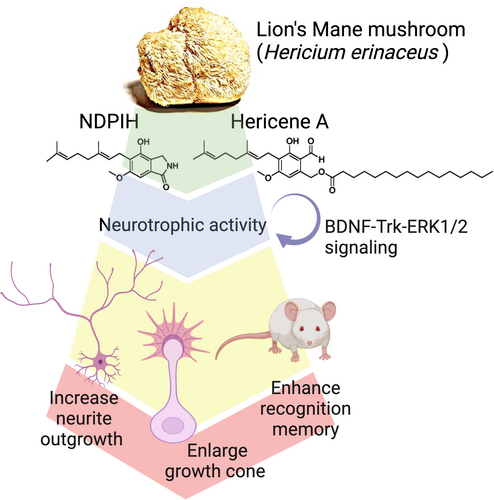Hericerin derivatives activates a pan-neurotrophic pathway in central hippocampal neurons converging to ERK1/2 signaling enhancing spatial memory
The traditional medicinal mushroom Hericium erinaceus is known for enhancing peripheral nerve regeneration through targeting nerve growth factor (NGF) neurotrophic activity. Here, we purified and identified biologically new active compounds from H. erinaceus , based on their ability to promote neurite outgrowth in hippocampal neurons. N -de phenylethyl isohericerin (NDPIH), an isoindoline compound from this mushroom, together with its hydrophobic derivative hericene A, were highly potent in promoting extensive axon outgrowth and neurite branching in cultured hippocampal neurons even in the absence of serum, demonstrating potent neurotrophic activity. Pharmacological inhibition of tropomyosin receptor kinase B (TrkB) by ANA-12 only partly prevented the NDPIH-induced neurotrophic activity, suggesting a potential link with BDNF signaling. However, we found that NDPIH activated ERK1/2 signaling in the absence of TrkB in HEK-293T cells, an effect that was not sensitive to ANA-12 in the presence of TrkB. Our results demonstrate that NDPIH acts via a complementary neurotrophic pathway independent of TrkB with converging downstream ERK1/2 activation. Mice fed with H. erinaceus crude extract and hericene A also exhibited increased neurotrophin expression and downstream signaling, resulting in significantly enhanced hippocampal memory. Hericene A therefore acts through a novel pan-neurotrophic signaling pathway*,* leading to improved cognitive performance.
Open access paper: https://onlinelibrary.wiley.com/doi/10.1111/jnc.15767

3 Likes
Bicep
#3
It’s funny, I’ve never heard of Hericene A, and neither has wikipedia. I don’t use it much so maybe I’m doing it wrong. I’ve always thought Erinacine A was the active ingredient.
Abstract: Hericium erinaceus (HE) is a large edible medicinal fungus. Erinacine A (ErA) is a secondary metabolite presented in the mycelia of HE, with pharmacological effects as a nerve growth factor on the central nervous system. In this study, solid-state cultivation of HE was carried out in Petri dishes and glass jars for the production of mycelial biomass and ErA. The potato dextrose agar (PDA) had the highest mycelial biomass at an optimal temperature of 25 ◦C, but no ErA was found in the agar media. In glass jar cultivation, the mycelial biomass and specific yield of ErA in different substrates, particle sizes, substrate weights, nitrogen sources, and inorganic salts were investigated. The ErA was purified by a self-pack silica gel column and a semi-preparative HPLC and was identified by liquid chromatography-tandem mass spectrometer. The best conditions for solid-state cultivation of HE when using corn kernel as substrate, particle size less than 2.38 mm, and addition of 10mM ZnSO4, 7H2O, mycelial biomass of 50.24 mg cell dry weight/g substrate was obtained, in addition, the specific yield of ErA could reach 165.36 mg/g cell dry weight.
It’s not as easy as it looks to make this work. I’m going to spend more time on it after harvest. I have plenty of corn. ErA is in the mycelium only.
2 Likes